To begin a blog with the observation that 2021 has been an ‘interesting year’ is a tiny bit of an understatement! Amidst ever-changing Covid-19 restrictions and lockdowns, it was certainly a challenging twelve months for a multi-stranded research project that relies on access to resources such as collections, sites and archives, but also a time presenting fresh opportunities and in which our work made great strides on several fronts. This start-of-year blog reflects on some of these successes and signposts some of the ways our project will continue to develop through 2022.
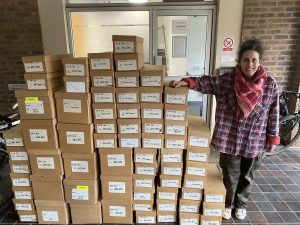
The assemblage of horse bones from the medieval horse cemetery site from Elverton Street, London arriving in the Archaeology Department at Exeter.
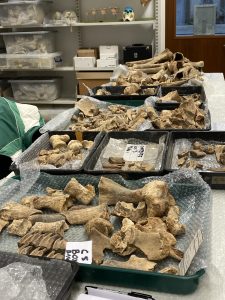
The Elverton Street horse bones in the bone laboratory at the University of Exeter for sorting, measuring, sampling and analysis.
The Zooarchaeological Work Package has seen new developments alongside ongoing activity. We were delighted that Kate Kanne, from Northwestern University USA, was able to join our research team, supported by Covid contingency funding through the University of Exeter, working alongside and complementing the activity of other zooarchaeologists on the project, Carly Ameen, Alan Outram and Helene Benkert. In recent months, Kate has been leading the way in sourcing assemblages of medieval horse bones for analysis at Exeter, including remains from some ‘classic’ sites of English medieval archaeology, such as Launceston castle, Cornwall, and the rural site of Goltho in Lincolnshire. One star acquisition has been the assemblage from Elverton Street, London, a site near Westminster excavated by the Museum of London, who we have collaborated with to facilitate analyses of the materials. As well as conducting our usual array of zooarchaeological techniques on these remains (including metric work, X-ray analysis and genetic sampling), an exciting new departure is the way that we have been able to sample the teeth from this assemblage for isotopic work (see this earlier post). We eagerly await the results and what they can tell us about where these animals came from. In this and several other aspects of our project, it has been fantastic to integrate University of Exeter Undergraduate and Postgraduate students into the work, with Masters student (and keen equestrian) Tess Townend leading the way with sampling the teeth as part of a coursework project.
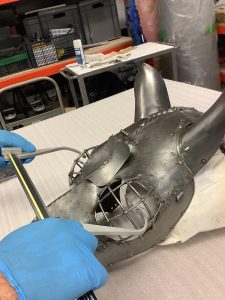
Recording of medieval equine material culture underway for the Warhorse project: measuring a shaffron (or head armour – note the mesh, providing eye protection in a joust).
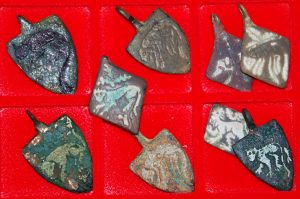
A selection of medieval horse harness pendants in a private collection. Note the representations of coats of arms and other symbols of noble families on the artefacts.
Our Material Culture Work Package, led by University of Exeter Researcher Rob Webley and supported by student intern Laura Jones, has progressed well on three main fronts. First, spatial analysis of digital records held by the Portable Antiquities Scheme has continued apace, with the publically accessible nature of the database continuing to be a godsend through periods of Covid-related lockdown. Among the many achievements are the mapping of equestrian apparel — especially horse harness pendants — bearing the coats of arms or symbols of prominent noble dynasties, which has allowed us to map the footprint of these families in new ways. Second, the easing of Covid restrictions as 2021 progressed enabled the team to make visits to two nationally important private collections of artefacts containing a wealth of medieval horse gear. These materials provide a really instructive means of gauging the typicality or otherwise of the Portable Antiquities Scheme data and for inspecting objects at first-hand, and we are delighted to have carried out the work. Third, the re-opening of museums and archives has meant that our programme of measuring medieval horse armour has resumed, with a visit to the amazing collections of Glasgow Museums already undertaken and firm plans for visiting and recording other internationally important collections in the UK and the USA in 2022.
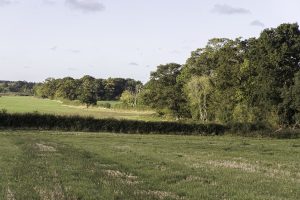
View towards the former Great Park at Stratfield Mortimer, Berkshire. The curving hedge-line marks the boundary of the medieval park, which contained an important horse stud.
Turning to our History and Landscapes Work Package, which is critical to our project’s interdisciplinary edge and scope, the research programme led by our team at the University of East Anglia (Rob Liddiard and Gary Baker), has continued to work through documentary material as much as pandemic has permitted. Related research on landscapes of horse breeding and training has proceeded by locating parts of parks associated with horses through field-names, historic maps and, of course engagement with arguably the most important source of all for this aspect of our project — the historic landscape itself. The image below shows one prime example of the site of a medieval horse stud that the team are interested in: Stratfield Mortimer, in Berkshire. This was a park of the Mortimers — a powerful aristocratic family based in the Welsh marches — that came under royal control for periods of the fourteenth century. The team’s analysis of financial accounts for the stud allow us to chart the numbers and types of horses bred and trained in the park in particular years, including records of numbers of foals born and the proportion of mares and stallions. At the University of Exeter, French researcher Camille Mai Lan Vo Van Qui has been making excellent progress on her work on manuscripts relating to a text on veterinary medicine and horse-training written in Latin by the Italian knight Jordanus Rufus (Giordano Ruffo) around 1250.
The year 2021 also saw our portfolio of publications growing. The first issue of the new journal Cherion: The International Journal of Equine and Equestrian History contains a paper co-written by the Warhorse project team that showcases our interdisciplinary approach and contains a case study of how our lines of evidence intersect to cast new light on the medieval stud at Odiham, Hampshire. A second significant publication is our study of medieval horse metrics in the International Journal of Osteoarchaeology. At the time of writing, our paper has attracted news coverage around the world, with members of the research team dealing with press and giving interviews for radio stations from Canada to Australia, and many places in between.
Alongside these academic outputs, our programme of outreach, which continued on digital platforms through Covid-lockdowns, has received new impetus, with displays at public events (see this earlier blog), and we have ambitious plans for the coming year including an appearance in the summer at the Tewkesbury Medieval Festival — arguably Europe’s largest medieval battle re-enactment.
Perhaps the most exciting thing of all is the way these activities, lines of evidence and routes of enquiry interact with one another. At outreach events, our team members can always be sure that members of the public will provide snippets of information providing new insight and perspectives — often relating to their own through practical work with horses — that can feed into our academic activities. Especially stimulating is the interaction between our work packages at different levels and the ways our research directions complement one another. Cutting-edge archaeological science can reveal things the documents are silent on, while material culture analysis can sometimes tell us about the appearance of specifically high-status and military horses in a way the bones cannot. Landscapes bring our entire subject to life, and illuminate the settings for equestrian activities. Documents, where they are available, can afford amazingly precise information on horses for certain years but absences in others, while our archaeological evidence is sometimes dated less precisely but affords us a broad picture over longer periods. This is the inherent fascination of our work, and as the project moves towards the final stages of data collection and as the results of analysis come in we look forward to sharing our results and achievements.